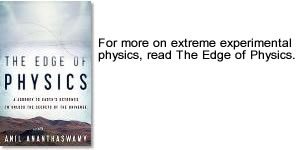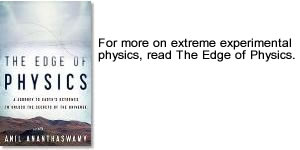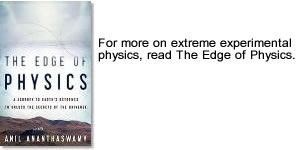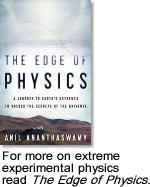Posts from — February 2010
Chile earthquake and telescopes
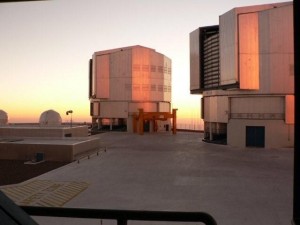
How giant telescopes in Chile are protected against earthquakes
The latest earthquake to hit Chile was located near Concepcion, just south of Santiago.
Sadly, early reports of fatalities are emerging. In addition to the unfortunate loss of lives and livelihoods, Chile has to worry about something that is of interest to the astronomical community: telescopes.
Given that Chile is one of the most seismically active in the world, it’s a wonder that the country hosts some of the most powerful telescopes on the planet. These include the European Southern Observatory’s Very Large Telescope (VLT) in Paranal, Chile. It’s high in the Chilean Andes, about 1600 kilometres from Santiago. Even the planned 42-metre European Extremely Large Telescope is most likely going to be built in Chile.
Eyewitness reports on the BBC say that the Concepcion quake was felt as far away as Pergamino, Argentina, 200 kilometres north of Buenos Aires and about 1800 kilometres from quake’s epicentre.
So, most likely, ESO’s facilities on Mount Paranal would have felt the quake.
The four 8.2-metre telescopes that make up the VLT are well equipped to deal with earthquakes. Here’s a paragraph from The Edge of Physics that describes how the primary mirrors of the VLT are protected when the Earth shakes:
- The primary mirror is 18 centimeters thick. Because of its weight, the mirror’s precise shape can warp when it is tilted, so 150 actuators, upon which the mirror rests, continually push and pull at least once a minute to ensure that the optimal curvature is maintained. More impressive than the actuators are the clamps around the edges of the mirror, which can, at a moment’s notice, lift the entire mirror, all 23 tons of it, off the actuators and secure it to the telescope’s support structure in case of an earthquake (moderate quakes, of less than 7.75 Richter, are not uncommon here, thanks to the ongoing collision of the Nazca and South American plates). The entire telescope is designed to swing during an earthquake, and securing the primary mirror prevents it from rattling against the metal tubes that surround it.
To see the 8.2-metre mirror and the actuators, click here for pictures (the mirror is the seventh in the slideshow).
February 27, 2023 10 Comments
The universe in a trillion years
The last blog post, Why Astronomy Matters, listed key astronomical observations that have fundamentally changed our understanding of the universe, and more importantly, our understanding of our place in the universe. We went from a scenario in which the Earth was at the centre to a sun-centred solar system, to an expanding universe that began in a big bang. The most recent set of observations in the late 1990s led to the discovery of dark energy, the energy that permeates the very fabric of spacetime and is causing the expansion of the universe to accelerate.
In a recent paper, Lawrence Krauss analyses the consequences of a universe dominated by dark energy whose density does not change with time (often referred to as the cosmological constant). One of the staggering implications of the cosmological constant is that in about 1-10 trillion years (which is comparable to the lifetimes of the longest-lived stars), all the astronomical evidence that led to the theory of the big bang will have vanished. Dark energy would have caused the expansion of spacetime to accelerate so much that all but the gravitationally-bound local cluster of galaxies (of which the Milky Way is a member) would have disappeared from sight. Given that we inferred the expansion of the universe by studying how distant galaxies are racing away from us, such a scenario would leave astronomers with little evidence of an expanding universe.
Krauss also points out that the cosmic microwave background (CMB) – the radiation leftover from the big bang, and another key piece of evidence for the big bang theory – would have been redshifted to such an extent as to make it practically unobservable. The wavelength of the CMB that would have the peak intensity would be larger than the universe’s light horizon.
So what would the universe look like to astronomers in such a universe? Krauss harkens back to a time when even Einstein thought that the universe was static, unchanging and eternal, a time before we knew of an expanding universe and a big bang. “Poetically their picture of the universe will not be significantly different than that which Einstein had when he developed general relativity: A static universe in which our galaxy was surrounded by eternal empty space, with which cosmology at the turn of the last century began, will have returned with a vengeance,” writes Krauss.
I don’t know about you, but that sends a chill up my spine.
February 20, 2023 No Comments
Why astronomy matters
During the writing of The Edge of Physics, I was struck by the role of astronomy in changing fundamental perceptions about our universe, ourselves and our place in the universe. In fact, each such epochal moment can be traced to a unique (set of) astronomical observation(s).
The Copernican Revolution, which helped fuel the Scientific Revolution, caused us to change our entire world view. Earth was no longer the centre of the solar system. Instead, Copernicus argued that the motion of planets was best explained if the planets revolved around the sun.
Fast forward to the early 1900s, when our entire universe was the Milky Way. Even Einstein thought so, which led to what he called his greatest blunder. When his own equations of general relativity showed that the universe had to be either contracting or expanding, Einstein introduced a “cosmological constant”—a fix that made the universe static. Then, Edwin Hubble and Milton Humason made a series of observations using the 100-inch telescope atop Mount Wilson which showed that the universe consisted of much more than the Milky Way. More importantly, almost all of these galaxies were moving away from us (astronomer Vesto Melvin Slipher should be credited with measuring the redshift of these galaxies before Hubble, but it was Hubble who showed that these galaxies lay beyond the confines of our galaxy).
With Hubble’s work (and the work of theoreticians), the idea of a Big Bang began to take hold. Our universe, it seemed, had begun in a fireball. But the theory had to share the stage with the steady state model of the universe. The Big Bang model was confirmed in the 1960s with the accidental yet monumental detection of the cosmic microwave background (CMB) – a radiation leftover from the hot early universe. While many, many more experiments had to be done to nail down the properties of the CMB, we think of the 1965 discovery by Penzias and Wilson as the beginning of the big bang-era.
Also in the 1960s came the discovery of dark matter – based on observations of how fast the stars and gas are moving in the Andromeda Galaxy. With Vera Rubin’s pioneering astronomy, our universe went from being made of matter to one in which nearly 90 per cent of the matter was made of unknown stuff called dark matter.
Nothing dramatic happened for a few decades. Then in the late 1990s came the discovery of dark energy. Again, it was a set of astronomical observations of supernovae that showed that the expansion of the universe was accelerating. The favoured explanation is this: the fabric of spacetime has inherent energy, which is causing the accelerated expansion. Significantly, our understanding of the composition of the universe changed beyond belief. We now think it is made of mostly mysterious stuff: 73 % dark energy, 23 % dark matter, and only 4 % normal matter.
Hidden in the discovery of dark energy is the potential for a revolution just as (if not more) significant than the Copernican Revolution. Physicists are struggling to explain why dark energy has the value it does. Nothing in known physics can help. It’s value seems to be just right for galaxies, stars, planets and hence life to form, and produce physicists who are asking the question: why is our universe the way it is? One idea – controversial, but by no means lacking support among big-name physicists – is that our universe is part of a multiverse, which is the name cosmologists give to an ensemble of universes (could even be an infinity of universes). In a multiverse, dark energy takes a random value in each universe, and we just happen to be living in which its value is conducive to the emergence of life.
How on earth do we ever detect other universes? Well, if we had a theory that predicted a multiverse, and we verified many, many elements of that theory in our universe, then we’d have to – however reluctantly – accept the existence of a multiverse. Here’s Steven Weinberg (quoted in The Edge of Physics): “The important thing is not whether you can observe every ingredient in a theory, the important thing is whether you can observe enough of the consequences of the theory to test it and confirm that the theory is right.”
If the existence of a multiverse is somehow verified by experiments, then the discovery of dark energy may become the astronomical observation that we will look back on as the one that begat a multiverse.
February 14, 2023 No Comments
Italian experiment continues to claim dark matter detection
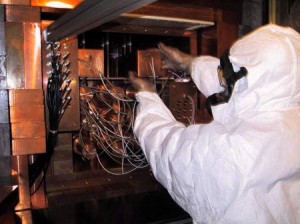
Photo: The DAMA/Libra Project
The controversial DAMA/Libra experiment announced this week that the experiment has further strengthened the case for the existence of dark matter in the galaxy. The problem is that no other direct detection experiment – and there are many of them – has been able to confirm the results.
For more than a decade now, the DAMA collaboration, which runs the experiment in an underground laboratory inside the Gran Sasso Mountain in Italy, has claimed that their experiment has seen evidence of dark matter. Most direct detection experiments look for signs of a dark matter particle hitting one of their sensitive detectors (and none have been found with statistical certainty yet). DAMA on the other hand is not looking for a single particle. Rather, it is looking for a change in the number of particles that hit its detectors on an annual basis.
The idea is that as Earth moves around the Sun, it should encounter a larger flux of dark matter particles on approximately 2 June relative to 2 December. The Sun is moving towards the star Vega in our galaxy. As the Earth revolves around the Sun, in June it encounters dark matter particles with a velocity that is the sum of its speed around the Sun and the speed of the solar system towards Vega. In December, the velocities are subtracted. Assuming that the galaxy is filled with a halo of dark matter particles, this difference in velocities is expected to lead to the change in the flux of dark matter particles encountered by detectors on Earth on 2 June relative to 2 December.
In April 2008, the DAMA/Libra collaboration reported that they had evidence of this phenomenon after 11 annual cycles of observation. Now, they have announced that 2 more additional years of observation have confirmed the same, one year of which was with an upgraded detector.
Much of the dark matter community has steadfastly ignored the DAMA/Libra data, mainly because it has proved impossible to confirm independently, and they think that the annual modulation signal is just some systematic noise (which the DAMA/Libra collaboration denies, saying it has accounted for all systematic noise).
However, there are growing attempts to start reconciling the two sets of results. If the DAMA/Libra experiment is indeed seeing dark matter, then it has to be squared against the negative results of other extremely sensitive experiments like CDMS-II and Xenon10. One candidate is so-called inelastic dark matter. See this paper for details.
February 5, 2023 No Comments

